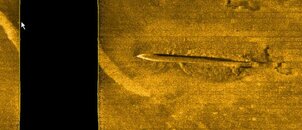Then you have strong feelings with diving nearly every wreck in the Great Lakes, the vast majority of which went down with total loss of life. The 1800's wrecks had a nearly complete history of 100% casualties. Many other later wrecks are the same. There's no difference between us diving the Carl D Bradley and diving on the Fitz.
It's certainly in the range of accessable wrecks, but would be a challenge thermally. Comparing it to the dives done in Grand Cayman is like comparing the Andrea Doria to the Speigal Grove.
The scalloping of the straight lines on her hull gunwales is caused by variations in towfish depth casued by sea state, possibly made worse by not having the fish deep enough, or towing too slow to reduce cable layback (likely done because the umbilical is too short to tow at the correct depth/speed). Result? The fish depth varies, and the scalloped image is the result. Fix: Calmer Days, or tow faster using a longer umbilical so that the catenary of the umbilical soaks up the surges of vessel motion.
Not that we've ever done any of the above... ;-)
Deep water is a challenge to small boat sidescan. At 450 KHz you can see reliably about 200 meters to each side, and the altitude above bottom should be 10% of the range. That means that you should be flying the fish at about 60 feet above the bottom. That's not really possible using lightweight (hand deployable, IE: not armored stainless steel cable) umbilical, even at three knots. Bottom line is that to look that deep with hand deployed umbilical, you need to have the fish hanging essentially straight down from the boat, meaning that you need to tow at nearly zero speed, where wave action really can begin to dominate the image. The bottom line is that you can look (sort of) but you cannot search an area using a system set up like that. The alternative is to use a longer and heaviier armored umbilical (smaller diameter, negatively bouyant, but not hand-deployable), and that means a powered reel... not something that most people have access to. Jitka and I do have one, and we run a Klein 3000 with both 100 KHZ and 450 KHZ transducers running at the same time. At 100 KHZ`we can look 1000 meters on each side... that's 1 KM, and we only need to put the fish down 200 feet to search in 500 feet of water. With 200 meters of armored stainless steel coaxial cable we can run that at 8 knots. That cable length lets us soak up boat motion with cable catenary. We do have a powered reel to haul it all back aboard though. GOOD LUCK hand-deploying a fish at the end of 200 meters of armored cable. Deep-water Sidecan stuff is expensive: Powered reels alone start at $10K.... without umbilical.
Not bad shots to start with. Looks like probably a Marine Sonic unit at 450 KHZ?
We are giving a talk at the Shipwreck and Technology symposium in Muskegon in a few weeks, and will be discussing sidescan in detail. Come and visit.
From Grapnel Hooks and Double Hose Regulators to Sidescan Sonar and Mixed Gas Rebreathers | shipwrecksandtechnolgy.org
Dave
.






